Future of MAM: Interoperability, open standards and unified workflow

Subscribe to NCS for the latest news, project case studies and product announcements in broadcast technology, creative design and engineering delivered to your inbox.
The era of isolated media asset management systems draws to a close as broadcasters demand solutions that work seamlessly across their entire content creation and distribution chain. This shift changes how media organizations approach integration, forcing vendors to embrace open standards and interoperable architectures.
“The days of MAM systems being glorified digital filing cabinets are over,” said Jan Weigner, CTO of Cinegy. “A modern MAM system needs to be the Swiss Army knife of broadcast – handling everything from ingest to distribution while enabling real-time collaboration.”
“As broadcast workflows become more nuanced, traditional, monolithic, and single-vendor technologies will be replaced by more modular, interconnected tools that can work harmoniously,” said Sean Lee, CEO at OpenDrives.
Integration reshapes system design
Integration capabilities now influence technology purchasing decisions as media organizations prioritize solutions that work within their existing infrastructure. The emphasis on interoperability extends beyond basic compatibility to encompass workflow automation, metadata exchange, and content distribution systems.
“When it comes to distribution, the focus has shifted from the M&E industry defining how media should be processed and delivered top-down to the content platform providers,” said Julian Wright, Blue Lucy CEO.
Modern MAM systems must support multiple file formats, codecs, and delivery specifications while maintaining compatibility with both legacy equipment and emerging technologies. This requirement drives the development of more adaptable systems that can evolve alongside industry standards.
“As media production teams go global, so must their Media Asset Management systems. Modern MAM systems are now cloud-based in that the data management function is performed in the cloud while the original media files can be stored alongside in the cloud or stored on premise,” said Whit Jackson, VP of global media & entertainment at Wasabi Technologies.
Standards and workflow evolution
Organizations seek systems that can adapt to changing production requirements without extensive customization. This flexibility becomes particularly important as workflows incorporate new technologies and production methods.
“Standards initiatives can play their part, but often applications and tools need to be built with interoperability in mind – making it quick for software companies, customers, or third parties to integrate tools together and share content,” said Jochen Bergdolt, global head of MAM business unit at Vizrt.
The integration of artificial intelligence services presents new opportunities for automated metadata generation and content analysis. These capabilities must work seamlessly within existing workflows to provide meaningful value.
“As broadcast workflows become more nuanced, traditional, monolithic, and single-vendor technologies will be replaced by more modular, interconnected tools that can work harmoniously with each other to form truly tailored workflow solutions,” said Lee.
Implementation and security considerations
Security considerations influence integration strategies as organizations balance accessibility with the protection of valuable media assets. Modern MAM systems incorporate industry-standard security protocols while maintaining workflow efficiency across multiple platforms and locations.
“The MAM implementation requires careful evaluation of each workflow touchpoint to verify compatibility with both current and emerging production tools, while selecting vendors who demonstrate commitment to open standards and extensive third-party integrations,” said Laquie TN Campbell, media and entertainment product marketing manager at Backblaze.
Technical integration challenges extend to storage systems, where organizations increasingly demand solutions that work across multiple platforms and locations. This requirement shapes both system architecture and deployment strategies.
“Broadcasters can ensure interoperability by prioritizing partnerships with technology providers who support robust API ecosystems and actively collaborate with other industry leaders across the entire pipeline,” said Campbell.
Return on investment for media companies
Implementation timeframes evolve as organizations expect faster returns on their technology investments. This drives a trend toward modular systems that can be deployed incrementally while maintaining interoperability with existing infrastructure.
“Time to value is critical. The protracted projects in which the return on investment takes many years cannot be tolerated in a market which is expanding and changing at the current rate,” said Wright.
Cloud integration introduces additional considerations for system interoperability. Organizations must maintain seamless operations across hybrid environments while managing costs and performance requirements.
“Legacy technologies aren’t keeping up with modern workflows, and with purchasing cycles creating natural opportunities for change, the focus is shifting toward smarter, more cost-effective solutions, with cloud and hybrid models taking center stage,” said Leanne Tomlin, marketing director, EMEA at Perifery.
The push toward standardization and interoperability continues to shape MAM system development. Organizations increasingly evaluate solutions based on their ability to integrate with existing tools while supporting future workflow requirements.
“Broadcasters will be experimenting with various types of workflows (traditional, remote, hybrid, cloud, IP) as they search for faster and more cost-efficient ways to produce compelling, profitable content,” said Lee.
This evolution in MAM systems reflects broader industry trends toward open standards and flexible architectures. Success in this environment requires careful attention to integration capabilities, security requirements, and long-term scalability needs.
Subscribe to NCS for the latest news, project case studies and product announcements in broadcast technology, creative design and engineering delivered to your inbox.






tags
Backblaze, Blue Lucy, Cinegy, Jan Weigner, Jochen Bergdolt, Julian Wright, Laquie TN Campbell, Leanne Tomlin, OpenDrives, Perifery, Sean Lee, Vizrt, Wasabi Technologies, Whit Jackson
categories
Broadcast Engineering, Broadcast Facility Technology, Content Delivery and Storage, Featured, Media Asset Management